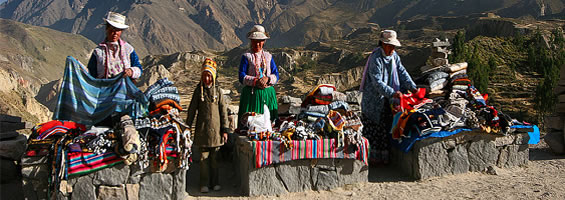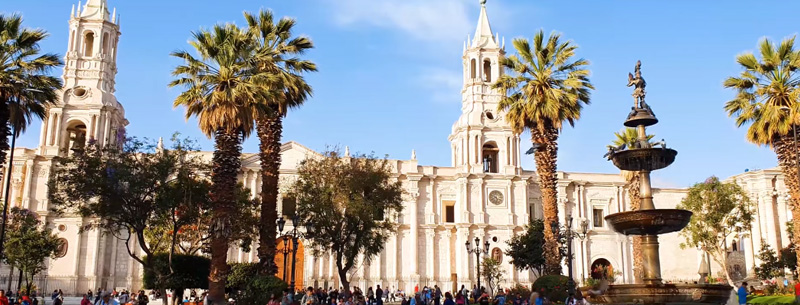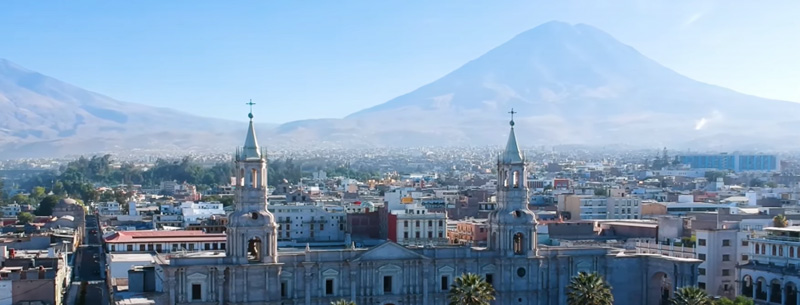Arequipa Peru Travel Guide
The city of Arequipa is fairly large but still beautiful, a city located just below the edge of the Peruvian Altiplano.
Arequipa is 1000km South of Peru’s capital Lima (best to catch a flight). The city has been declared a UN World Heritage site and has many fine colonial buildings, churches, and cobbled streets to explore. The Santa Catalina Convent is the top travel highlight of Arequipa – an amazingly beautiful walled colonial city was 400 nuns used to live in seclusion.
Arequipa’s surrounding countryside offers some lovely hikes – to climb the nearby El Misti volcano is not an overly challenging task. The town is worth a few nights as a travel base, but many people choose to catch a morning flight from Lima and spend just one night (visiting the Santa Catalina Convent on their first afternoon), before traveling on to Peru’s amazing Colca Canyon.
Top of the range hotels in Arequipa includes the Libertador Ciudad Blanca or the Sonesta Posadas del Inca (though neither could be considered genuine luxury hotels as are found elsewhere in Peru).
Arequipa is a city in southern Peru and the nation’s second-most-important city. It is also the capital of the Arequipa Region and the Arequipa Province. The city stands at the foot of the snow-capped volcano El Misti, in the highlands. Arequipa has many fine colonial-era Spanish buildings built of sillar, a pearly white volcanic rock used extensively in the construction of the city, from which it gets its nickname La Ciudad Blanca (“the white city”).

Location: Southern Peru, Andean zone, 2,335 meters above sea level. (7,660 feet)
The city of Arequipa
The city of Arequipa is located above 2325m. Enjoys an eternal spring, sunny weather almost the whole year. It has temperatures between 20°C and 24°C during the day and at night it gets cooler.
Arequipa has a population of approximately 700,000. However, it has the feel of a small town. Arequipa is a beautiful city that had worked hard to retain its provincial charm. The relaxed pace of this colonial city high in the Andes is a welcome respite from the hustle and bustle of Lima.

The city of Arequipa is surrounded by volcanoes and deep gorges, all in a vast desert, it is easy to understand why the relatively benign geography of the valley of Arequipa, and its vegetation provided by the irrigation of the River Chili, attracted its first Spanish settlers. The city of Arequipa was founded, or at least re-founded, on August 15, 1540, by Francisco Pizarro’s envoy, and in 1541 the king of Spain gave the city the title of Villa Hermosa – beautiful city.
Normally Arequipa is also known as the “Ciudad Blanca” (White City) for the numerous and magnificent constructions of temples, convents, big houses, and palaces in white ashlar sculpted as filigree. It also possesses an excellent climate with almost 300 days of sun a year, with a transparent blue sky.
Departaments of Arequipa:
• Camana
• Chala, Puerto Inca
Best of Arequipa
Colca Cayon
Colca Cayon is the main attraction of the area. It must be done in a 2 days excursion or more. That’s one of the deepest canyons in the world and a great chance to see wild condors. I’m not religious but is also nice to see some of the city monasteries as the Santa Catalina one that is the special cause is a little closed Citadelle with all the facilities inside. The Cathedral at the Plaza de Armas is also beautiful and some visits to colonial houses like Casa de Los Mendiburos, Casa del Moral, or Goyeneche Palace.

Tingo
Located south of Arequipa, this town with its watering places and small lagoon, as well as weekly cockfights, attracts large Sunday crowds.
Yura
Located 25 km (15.5 miles) north of Arequipa, near the volcano Chachani. This is a population on which exists watering places assorted by springs of thermomedicinal l water, ferruginous water, and sulfurous water. It has lodging for patients and tourists. It also has a beautiful chapel. Very close to this place in the north part you can find the Socosani springs.
Cayma
Is located in a high area. Cayma offers an excellent view of Arequipa and is often referred to as the “Balcony of Arequipa”. On the main square, the ancient church of San Miguel Arcangel (1730) is considered to be a jewel of the blended styles of colonial architecture. To the right of the temple is a dining room called “Comedor de Bolívar” and a small art museum. Here it is also a traditional celebration of the Feast of “Virgen de la Candelaria”.
It’s possible to climb up to the roof of the church (daily 9 am-4 pm).
Quequeña
Located in the countryside, 15,000-year-old stone carvings can be found near the town.
Yanahuara
Is also located in a high area, it has a main plaza with a beautiful church (1750), whose facade is finely sculpted in ashlar. Nearby you can find Yanahuara’s “mirador” (or scenic overlook) which affords a beautiful view of the city of Arequipa.
Folklore in Arequipa
The region boasts a large variety of dances accompanied by different costumes, the most important being probably the Carnaval Arequipeño, a group dance that is present during the week of carnival and the city’s anniversary (August 15th) ; the Yaraví, of Quechua origin; the Pampeña, a primitive huayno in which dancers dress on farmer costumes. The most genuine musical _expression of Arequipa is the Yaraví. Other popular expressions of Arequipa’s musical folklore include the Carnaval Arequipeño, the popular Huayno, and the Pampeña.
The most characteristic dances are the Arequipeño Carnival, a typical group dance of the celebration of the carnivals, and also the anniversary of the foundation of the city (15 of August).
Other dances are also witite, camile, tin, huaylas (farmers).
Getting to Arequipa
By Train
Charter trains to Juliaca and Puno are only available for groups of 40 or more, However, also trains from Cusco to Arequipa.
By Plane
By far the easiest way to get into/out of Arequipa is by plane. Lan flys twice daily from around $37.
By bus
Several buses a day do the long trips to Cuzco (10 hours, 25 soles), Puno, Camana (3 or 4 hours, 10 soles), Pisco (10-12 hours, 30-100 soles), Nazca, Lima (cheap bus for 30 soles, takes 15 hours, more expensive buses are faster) and Tacna (near the border with Chile). Normally in the holidays, the price trips are expensive, In general, you get what you pay for with buses, but it still doesn´t hurt to ask about the quality of the bus before you buy your ticket. Some of the more reputable companies are Ormeño and Cruz del Sur.
Arequipa History
The modern city of Arequipa was founded on 15 August 1540, by Garcí Manuel de Carbajal, an emissary of Spanish conquistador Francisco Pizarro.
Arequipa was named “The White City” (La Ciudad Blanca). This led Arequipa to develop a large Peruvian Mestizo population as its demographics changed and grew over the centuries.
Throughout history, Arequipa remained relatively isolated during the colonial and early republican times, but that changed in 1870 when a Southern railroad to the coastal port of Mollendo was inaugurated, opening trade via the Pacific Ocean. The building and expansion of more roads in the 1930s also led to a direct connection with the Pan-American Highway, strengthening Arequipa’s links to the rest of the Americas. Since then, the city has remained the center of commerce between Lima and all of Southern Peru.
The city of Arequipa served as a bastion of nationalism during Peru’s struggle for independence from Spain in the early 19th century. Later, it served as a rallying point during the War of the Pacific (1879 – 1883) with Chile.
The city has 2 principal universities(the Universidad Nacional de San Agustín de Arequipa, the local state university (founded 1828), and the Universidad Católica de Santa María (founded in 1961)), a private institution.
Arequipa is influenced by both Andalusian and Spanish Colonial ideas and architecture, such as the popular Santa Catalina Monastery, the Goyeneche Palace, and the Casa del Moral. The city of Arequipa has several valuable archaeological and touristy resources including the Colca Canyon, one of the deepest in the world, and an ideal spot for observing the magnificent Andean Condor.
